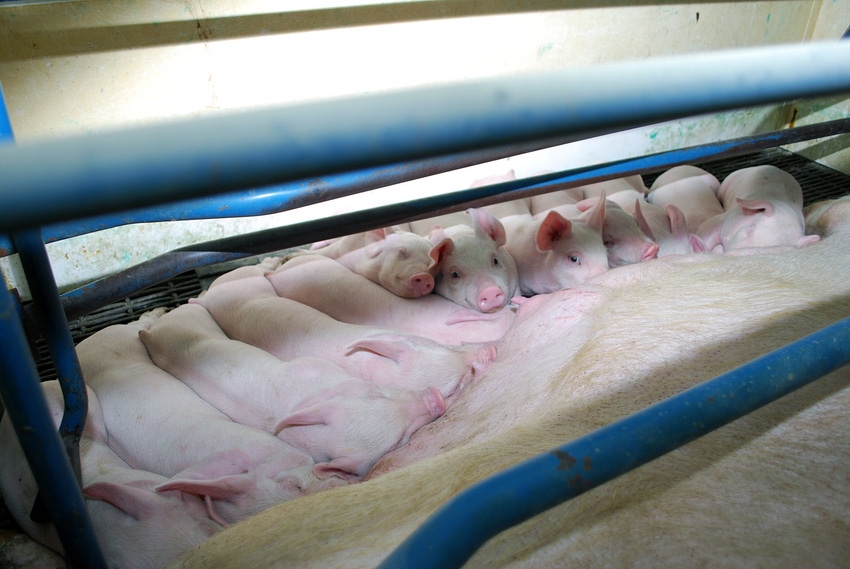In this study, we successfully demonstrated that sow milk concentrations of ARA and EPA can be increased progressively by supplementing these LCPUFA in sow diets.
June 14, 2018

By Eric van Heugten, Petra Chang and Jack Odle, North Carolina State University Department of Animal Science
Reducing piglet mortality pre- and post-weaning and improving the transition of pigs into the nursery have major implications on the profitability of pork production. Throughout lactation, a piglet’s only source of nutrition comes from the sow’s milk, which is followed by a dramatic change at weaning, when pigs are separated from their dams and usually offered a dry diet as their only means of nutrition. The ultimate results of this weaning stress are decreased growth performance post-weaning, increased number of no value pigs, decreased gastro-intestinal health and increased veterinary intervention to treat pigs suffering from diarrhea.
Long-chain polyunsaturated fatty acids, as precursors of prostaglandins, have been shown to improve intestinal barrier function and recovery following intestinal injury. The intestinal mucosa of suckling piglets can be enriched with LCPUFA by feeding increasing levels of these compounds and can provide protection against intestinal damage. We hypothesized that supplementation of the sow diet with LCPUFA will enrich sow milk and subsequently the intestinal tissue of the nursing piglet with LCPUFA. We focused specifically on arachidonic acid (C20:4 n-6) and eicosapentaenoic acid (C20:5 n-3). By delivering these fatty acids through the milk, we expected to prophylactically promote gut health, thereby improving survival and performance.
We conducted a study to determine the dose and duration of ARA and EPA supplementation required to efficiently enrich sow milk and intestinal tissue of suckling piglets and to determine its effects on pre- and post-weaning performance of pigs in a commercial production flow.
Sixty sows were assigned to five dietary treatments, consisting of: 1) Control (palm kernel oil); 2) 72.5 grams per day of ARA; 3) 145 grams per day of ARA; 4) 72.5 grams per day of EPA and 5) 145 grams per day of EPA. Sows were supplemented for 14 days prior to weaning with lipid mixtures containing the targeted concentrations of ARA and EPA once daily. Concentrations of ARA in milk increased linearly (P<0.001) with ARA supplementation on Day 6 and 13 and were higher on Day 13 compared to Day 6 for the 145 grams per day ARA treatment (Figure 1). Similarly, milk EPA concentrations linearly increased (P<0.01) with EPA supplementation on Day 6 and Day 13 and tended to be higher on Day 13 compared to Day 6 when 145 grams per day of EPA was fed.

Figure 1: Impact of supplementation of control lipids (palm kernel oil), arachidonic acid or eicosapentaenoic acid on ARA and EPA concentrations in sow milk.
Concentrations of ARA and EPA in intestinal mucosa of piglets, measured after seven and 14 days of supplementation in lactation and seven days post-weaning, linearly increased (P<0.01) with ARA and EPA supplementation, respectively (Figure 2). Mucosal ARA and EPA concentrations increased during lactation, but decreased after pigs were weaned.

Figure 2: Impact of supplementation of control lipids (palm kernel oil), arachidonic acid or eicosapentaenoic acid on ARA and EPA concentrations in intestinal mucosa of suckling pigs measured after seven and 14 days of supplementation of the lactating sow and in weanling pigs, one week post-weaning.
In this study, we successfully demonstrated that sow milk concentrations of ARA and EPA can be increased progressively by supplementing these LCPUFA in sow diets. Increased ARA and EPA in milk directly influenced ARA and EPA by increasing enrichment in the intestinal mucosa of piglets. The effect that this enrichment with ARA and EPA may have on survival rate, growth rate and total weight of pigs produced by the sow remains to be evaluated in large-scale studies.
You May Also Like



